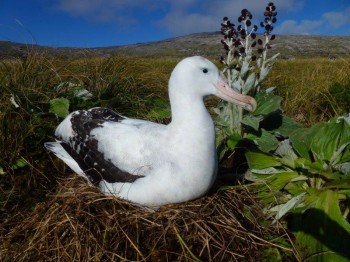Kalinka Rexer-Huber (Parker Conservation) and colleagues have presented a draft final report to New Zealand’s Department of Conservation at a meeting of its Conservation Services Programme (CSP) Technical Working Group late last month that details their field research on three ACAP-listed species on the Auckland Islands. The three taxa are: Antipodean Albatross of the Gibson’s subspecies Diomedea antipodensis gibsoni, White-capped Albatross Thalassarche steadi and White-chinned Petrel Procellaria aequinoctialis.
The report’s summary follows:
“This report details the mark-recapture methods and findings for white-chinned petrels, Gibson’s albatrosses and white-capped albatrosses. For Gibson’s albatross, we present data on the size of the nesting population in 2019, and updated estimates of survival, productivity and recruitment to help identify causes of current population size and trends. We also document tracking methods and device recoveries for all three species, and for white-capped albatrosses, describe nest camera recoveries and aerial photographic work.
White-chinned petrels. Three global location sensor (GLS) tracking devices were recovered and forty-seven banded white-chinned petrels were recaptured (recapture rate 0.27). Some burrow-switching has occurred, with three banded birds in new burrows ~2–5m from the burrow where first banded, justifying checks in unmarked burrows. With further banding this season, the study area now contains 230 banded white-chinned petrels in 131 marked burrows. Further resighting effort is needed before demographic parameters can be estimated reliably.
Gibson’s albatross. Nesting success has returned to levels recorded before the 2005 crash and appears to have stabilised, with 61% productivity in the 2017–2018 breeding season. The survival rate of adult males and females is now similar though survival remains below pre-crash levels. Breeding numbers in 2018-2019 continued the slow post-crash increase. The total estimated number of breeding pairs of Gibson’s wandering albatrosses in 2018–19 was 4,180, just under half the number of pairs breeding in 2004 (i.e., 8,728) before the population crashed. With annual mortality a little higher than it used to be, a total population substantially smaller than it used to be and more than a decade of low chick production, population recovery is likely to be slow.
White-capped albatross. Banded white-capped albatrosses were resighted at a rate of 0.34, and a further 122 breeding white-capped albatrosses were banded bringing the study colony total to 679 birds banded. Four GLS tracking devices were retrieved, and one further bird which had lost its GLS (or had it removed) was resighted.
Nest cameras gave up to 9½ months of data from deployment in January 2018. Chick success, or the survival of a chick from hatching to fledging, was lower than expected at 0.29 (5 out of 17 nests). Chicks fledged ~27 July (range 12 July–23 August), and adults returned to the colony from around 30 September. Low chick success is a concern since breeding success (survival from egg lay to fledging) will be lower than chick success. To estimate breeding success, nest cameras must follow the full breeding season, and all parameters (chick success, dates of fledging and adult return) would benefit from following more nests than in this trial.
Aerial photographs of the Disappointment Castaways B area were taken on 7 February around 1400 hrs. 260 suitable photos have been archived for interpretation at a later date. The main difference to previous aerial photography work is the timing: photographs in 2019 were taken 3 weeks later. Nest counts from these photographs will have to be corrected for breeding failures during incubation.”

Gibson's Antipodean Albatross on Adams Island, Auckland Islands, photograph by Colin O'Donell
The Conservation Services Programme monitors the impact of commercial fishing on protected species, studies species populations and looks at ways to limit bycatch. The programme is funded by levies from commercial fishers.
With thanks to Graham Parker.
Rexer-Huber, K., Elliott, G., Thompson, D., Walker, K. & Parker, G. 2019. Seabird populations, demography and tracking: Gibson’s albatross, white-capped albatross and white-chinned petrels in the Auckland Islands 2018-19. DRAFT FINAL Report to the Conservation Services Programme, Department of Conservation. Dunedin: Parker Conservation 19 pp.
John Cooper, ACAP Information Officer, 12 June 2019

 English
English  Français
Français  Español
Español